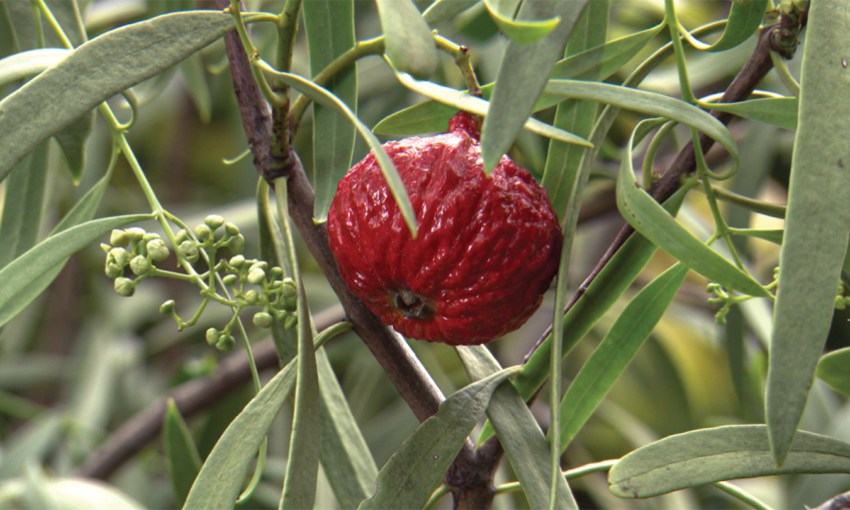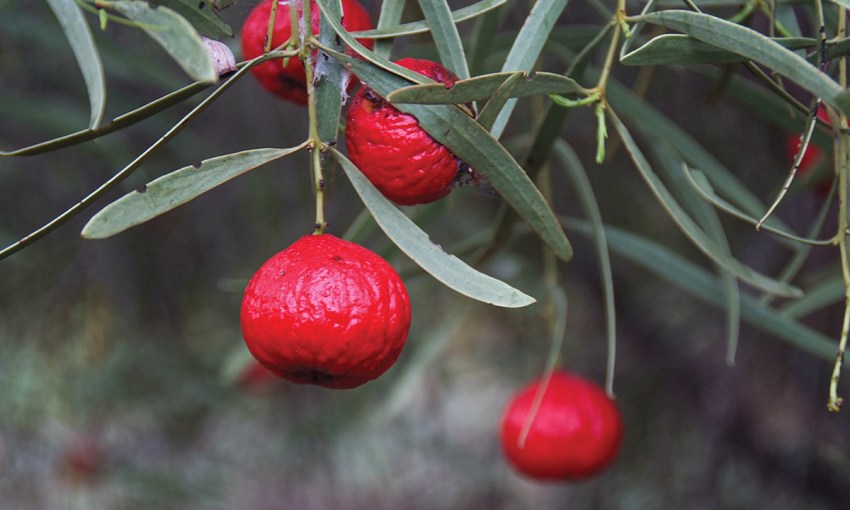Quandongs, with their hardiness, tart and tangy fruit and clusters of cream flowers, could well be the plant your garden has been missing.
Life’s a peach
Quintessentially Australian, the quandong (Santalum acuminatum or native peach) is a bush tucker standout that deserves a place in more home gardens. For tens of thousands of years, the quandong’s bright red fruit and round canopied tree have provided valuable nutritional, medicinal and practical uses to Indigenous populations across central and southern Australia. Early settlers, too, relied on quandongs to supplement their diets and help sustain life in harsh conditions.
Attendees at the inaugural Quandong Festival held in Quorn last August will also attest to this fruit’s wonderful attributes and culinary uses – you certainly can’t pass up a piece of quandong pie.
The words “drought tolerant” and “fruit tree” are not often combined, however they link perfectly when describing quandongs. Having adapted over millions of years to growing in nutrient poor, often saline soil and yet still able to produce a crop annually is testament to the plant’s exceptional hardiness.
Clusters of cream flowers blossoming from mid-summer form fruit over winter that ripen into unique shiny globular drupes ready for harvest from spring onwards. You can pick them once they have deepened in colour.
Quandong fruit consists of a thin white or cream flesh layer over a large, deeply pitted stone. Tart and tangy to taste, the flesh is packed full of goodness, being highly nutritious and containing twice the vitamin C of an orange. Use your fingers to peel away the flesh; its relative dryness means the flesh comes away from the stone easily.
While this outer layer can be eaten fresh, most recipes call for dried quandong, so crank up the dehydrator. Dried fruit will reduce in size and can last up to eight years when sealed and away from moisture. Alternatively, you can freeze fresh quandong for later use too.
Not only is the flesh edible, so too is the kernel inside the stone. The single white nut can be eaten raw, although roasting extracts its earthy flavours, similar to an almond. The outer casing is very hard, so cracking is a must. Rather than bashing with a hammer, which is likely to damage the nut, use a nutcracker; the B.O.N.K. nutcracker, designed to crack macadamia, works a treat.
Quandongs are hemiparasitic, tapping into neighbouring plant root systems to source water and nutrients. In their bush environment, they can be found close to nitrogen-fixing host plants, such as acacia, casuarina and leguminous shrubs.
While the quandong’s pale green eucalypt-type leaves are perfectly capable of photosynthesising (and do), the additional energy gained from its neighbours helps each plant to grow, maintain a thick foliage cover
and carry fruit.
Attractive, evergreen and growing to between four-to-six metres high with a broad umbrella canopy, quandongs tick the box for suitable trees in a suburban yard.
The key to their success in a home garden is access to a host plant or plants. Potted quandongs for sale, will generally have a myoporum, a brilliant hardy native ground cover, included in the same pot to act as its host. Plant them both out together. The trees take around five to seven years to reach full maturity.
Emus have played an important role in quandong distribution. After eating the fruit, travelling emus would deposit them, along with a little manure, at sites all around the country. The emu’s digestive system aided in germination, by helping to break down the hard shell allowing the roots and radicle to emerge.
Inconsistent seed propagation has contributed to low commercial numbers and lack of plant availability in garden centres, however research by various organisations, including the CSIRO, has seen improved growing techniques along with new cultivars. A number of local specialist nurseries now carry reliable stock numbers throughout the year.
Quandong seeds can be purchased through mail order nurseries for those keen to have a go at growing their own. There are many varied methods to successful germination, starting with cracking the nut. Some suggest squeezing in a vice, others prefer a gentle tap with a hammer. The Australian Native Plants Society website (anpsa.org.au) provides a comprehensive step-by-step method to raising quandongs from seed.
Just make sure you pick a sunny, well-drained spot to pop in a quandong, along with a nearby host. Then you can dream about baking quandong and rhubarb pies, or cooking up quandong jam. Bush tucker at its best. Why not try this recipe, which is perfect for adding some special Aussie flavour to the cheese platter.

This article first appeared in the Autumn 2023 issue of SALIFE Gardens & Outdoor Living magazine.



